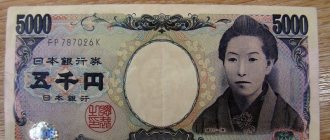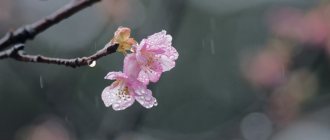Counting in Japanese is a cumulative system formed from its own numbers and borrowed from the Chinese language. Due to duplication, each number has two reading options: kunny, onny. Both classical numbers and Arabic notation are used in everyday life. The first option is more common when writing vertically, the second is used when writing horizontally.
1
Numerals in Japanese
According to modern rules, onic reading is used for all numbers other than 4, 9. In the names of months, these two numbers can be read according to onic rules. The reason for the special relationship is in their sound: it coincides with the words death and suffering.
If the number is read numerically (for example, 109 as "one-zero-nine") then the 0 is replaced by the word "circle". The number 0 in Japanese sounds like “zero”, the circle sounds like “maru”.
Some numbers in Japanese are found in the names of places and names. Most often - a thousand.
When counting a small quantity and volume at the beginning, it is permissible to skip a unit; if the quantity exceeds 10,000, the unit becomes a required component.
Japanese numerals for tens consist of a multiplier and the character for 10. Hundreds are formed in a similar way: the quantity indicator is put, then the character corresponding to 100. In the past, a special multiplier “co” was used for numbers in the range 30-90. Now it is used in speech only in certain areas, more often in the conversation of older people.
When dividing a large number, the Japanese divide it into blocks of four, not three characters each, as is customary in Europe. Example: a European writes 10121315 as 10 121 315, while a Japanese groups the numbers differently - 1012 1315. The difference is due to history: back in 1627, the first scientific material dedicated to mathematics, Jinkoki, was published in the Land of the Rising Sun. Although it contained many errors and was subsequently republished with corrections, a number of rules established by the authors firmly entered the life of the Japanese and became part of everyday life.
If a Japanese chooses to write in Arabic numerals, he writes them in American style. Every three characters a comma is placed to indicate the rank. When writing a number less than mana, you can combine Arabic characters and traditional Chinese characters: for example, 25,000,000 is written as 2,500万.
Although the counting system of the Land of the Rising Sun has fractions, like any other country, they are rarely used in everyday life. Most often, fractions are used to indicate the size of a discount or in sports when calculating game statistics.
Numerals are often found in male names and show the order in which children are born: the first son is called Ichiro, the second Jiro, the third Saburo, and so on. Names beyond Saburo are rare. Sometimes children are given names with numbers without reference to the number of brothers: Hyakuro is the hundredth son, Jyushiro is the 14th son.
A peculiarity of the language of the Land of the Rising Sun is the use of official symbols instead of the usual hieroglyphs in financial documents and other particularly important papers. The purpose of this complication is to eliminate falsification of documentation. The official daiji characters often replace the numbers 1, 2, 3, since these characters can easily be converted into one another. Money is considered to be the official symbol, so it is daiji that mark banknotes of 1,000, 2,000, 5,000, 10,000 yen.
1,000 yen banknote
Number 7
The number 7 is considered the luckiest number. There are 7 days in a week, 7 deadly sins and seven virtues, 7 continents, 7 colors of the rainbow, 7 musical notes, 7 days of Creation
and much more.
In Europe there is a belief that the 7th son of the 7th son has magical powers. Also, the number 7 is most often the favorite number of people around the world.
Japanese numbers from 1 to 10
Counting and writing up to 10 in Japanese is as follows:
- One is ichi (一). When pronounced quickly, the last vowel is dropped, the word sounds like “ich”.
- Two – no (二).
- Three – san (三). Although it sounds like a mountain, the hieroglyphs are different.
- Four – en (alternative reading – shi) (四).
- Five - go (五).
- Six is roku (六). For a non-Japanese person, pronouncing this word correctly is not easy, since the first sound is something between r and l. When pronouncing, you need to use only the tip of your tongue.
- Seven – nana, rarely shichi (七).
- Eight – hachi (八). When speaking, you need to pause briefly between syllables.
- Nine – ku (九). A common mistake made by Japanese learners is turning the vowel into yu. This is incorrect: there should be a distinct y at the end.
- Ten – ju (十). The first letter is simultaneously similar to dz, zh and j.
When counting objects, not only numerals are used, but also suffixes indicating what exactly is being counted. If you cannot find a suitable suffix, you can use a simplified count:
- One is hitotsu (一つ). The first character corresponds to ichi from the sequence above, the second is taken from hiragana.
- Two – futatsu (二つ). The education system is similar to that described above.
- Three – mitsu (三つ). When pronounced, there is a slight pause between syllables, and the sound “ts” is somewhat lengthened, as if it were a letter and a half. If you write the word in alphabet, it will look like this: みっつ. The small symbol in the center means doubling the next sound.
- Four – yotsu (四つ). There is a short pause between syllables.
- Five – itsutsu (五つ).
- Six is mutsu (六つ). After the first syllable there is a short pause.
- Seven – nanatsu (七つ). When speaking, you need to pause before the last syllable.
- Eight – yatsu (八つ).
- Nine – kokonotsu (九つ). There are two pauses in speech: after “koko” and the next syllable.
- Ten - that (十). Of the ten, this word is the only one without the final hiragana character つ.
The system is based on kun reading, that is, traditional Japanese numbers.
To form an ordinal number, it is enough to add the sign 目 (me) to each of the kun numbers. Hitotsume is the first, futatsume is the second.
Counting in Japanese
—> “Creounity Time Machine”: coin dating, history, writing
| News and updates ↓ 05/05/2020 — Added a new section: Samaritan chronology systems. 03/01/2021 — A new (28th) system has been added: The revolutionary chronology system in Haiti in the 19th century. 06/14/2021 — A table with an interpretation of the names of the months of the Muslim calendar has been added to the page dedicated to the lunar hijri. |
In short, “ Creounity Time Machine ” is one of the most famous (used in 213 countries and territories around the world) and functionally the most comprehensive online tool for determining (identifying) and converting dates (years) on the coins .
" Creounity Time Machine " is a date converter for numismatists using 28 chronology systems. With this universal and convenient converter, you can easily and quickly determine the year of minting of your coins , while at the same time discovering a lot of new things from the history and culture of different countries.
Using the Time Machine is interesting and educational. To launch it, just select the calendar system you need from the list on the left.
The converter works in both directions, i.e. converts dates from the chronology systems indicated on the left side of the page to a date according to the Gregorian calendar, and also back - the Gregorian year to the system of your choice (the year will be displayed in the symbols of this system).
Simply enter the date symbols into the converter as you see them on the coin. Cases when you need to enter any additional characters are specifically discussed in the descriptive part.
Each chronology system is accompanied by a story, information from which will help you understand in more detail the various aspects of the chosen system and learn about the history of its origin.
Opinions of experts and professionals about “Creounity Time Machine”:
“The resource is not just needed, but vital. Many have already tried to implement something similar, but no one has gone so far and deep yet. So all that remains is to congratulate you on a job well done and wish you every success in its further development!“
— Alexander Krotov
, author of the numismatic site
coins.numizmat.net
* * *
"Cool! I always used tables in Krause, yours is more interesting. Great. I really liked both the content and the design.”
— Evgeniy Shein
, member of the “Numismatics, Bonistics and Faleristics” community on the website
baku.ru
* * *
„Very useful resource. I think this serious work will not go unappreciated by numismatists and search engines.”
- Wanderer
, registered user
of the Violity forum
(forum.violity.kiev.ua)
* * *
Nikolay
: Interesting... I can’t even imagine what direction to move in order to create a project that would surpass facebook...
EsLex
: creating a time machine.
EsLex
: this is the right direction.
Quote number 408494
from the site
bash.org.ru
* * *
"Good day, Andrey! I really liked your project (I came to it to read everything about the Republican Calendar, and couldn’t leave - I got engrossed)! Thank you very much, very interesting!”
—Daniil
aka
Daniel Klingongsky
* * *
“Amazing site, very convenient.”
— saroff
, registered user of
the leshiy.su forum
* * *
„I really like this service. Made with soul."
- vbif87
, registered user of
the coins.su forum
* * *
“...I can recommend the excellent service “Creounity Time Machine” for dating - section “Thailand.”
— Timur Khusyainov
, owner of the blog
husyainov.ru
, in his article “Dating of Thai coins”
* * *
“On the Internet there is a very interesting service “Time Machine”, with which you can find out when this or that Thai coin was issued. The service is interesting, you can easily get stuck for half an hour looking for old coins.”
— Evgenia
, user of the site
pattaya.zagranitsa.com
* * *
“And if you have a computer, then the simplest thing is “Time Machine”: enter the numbers, click “Calculate”, and the result is ready!”
- olegator 7
, user of the site
evpatorg.com
* * *
“Very useful and cool program, I’ve never seen anything better! Thank you!"
— Motrov S.A.
, Arkhangelsk region, Severodvinsk
* * *
“There is an interesting resource, you can calculate it automatically.”
— Genya115
, user of
stareishina.com
* * *
“Thank you very much, the program is interesting and useful. The main thing is that you don’t need to download or install anything—everything is online. And there are descriptions for each chronology system, that is, this is not just a bare calculator.”
— Astireme
, user of the site
coinshunter.ru
* * *
„I like this resource. I think it will be useful to many. Reads all coins.“
— Katso
, user of the site
rasmir.com
* * *
“Thank you, Andrey. Your converter is like a lifesaver.”
— Oleg Kulakov
* * *
“So much interesting, educational and necessary information! Maps, pictures, tables - a huge job has been done!“
—Centurion
, forum user
borgen.mybb.ru
* * *
„Thank you for the wonderful site! Sometimes I use it to determine dates on some coins (Thailand, for example :)"
— scull
, forum user
coins.lave.ru
* * *
“For the convenience of quickly converting dates from the Islamic calendar to the Gregorian calendar, there are many programs. This is one of the most convenient.”
— Sterling
, forum user
forum.castlecoins.ru
* * *
“I came across it on the net =) Helps you conveniently and quickly determine the year.”
- fierce beast
, forum user
forum.ivpoisk.rf
* * *
“Thank you very much, several more of my friends are now using your system, and everyone is very grateful to you.”
— Galina Ter-Mikaelyan
, writer
* * *
“Thank you!” Titanic work! I have been recommending your site to the whole community of collectors for the third year now, no one has complained :-)“
— Yuri Kutyurin
, author of the website
coinhobby.ru
* * *
“Your site is wonderful, thank you! I am pleased to use your page on dating Bosporan coins.”
— Alexander Noskov
, Russia, Krasnodar
* * *
“I recommend this resource to inquisitive researchers for thorough study.”
— Filat
, forum user
sobiratel.org
* * *
“I thought that by creating my website and application for Android phones, I had done a great job. I looked at your resource and realized that this is not so. You approached this so meticulously... It gives me goosebumps =) “
— Alexander Bychkov
, author of the website
numizman.ru
(Rostov region, Kamensk-Shakhtinsky)
| I express my special gratitude - in absentia - to Alexander Alexandrovich Shchelokov (05/01/1926–02/02/2011) for the book "Fascinating numismatics" (show/hide bibliographic description)
Andrey Tretyakov, Samara→Moscow, Russia, summer ҂ВѲ–҂ВКА |
Tens in Japanese
The formation of tens in Japanese is simple: the required number is selected, the character 10 is added to it. For example, 20 is written like this: 二十, that is, 2-10.
Tens sequence:
- 10 – ju (十);
- 20 – niju (二十);
- 30 – sanju (三十);
- 40 – enju (四十);
- 50 – goju (五十);
- 60 – rokuju (六十);
- 70 – nanaju (七十);
- 80 – hachiju (八十);
- 90 – kyuju (九十);
- 100 – hyaku (百).
Japanese numbers
Googol number and googolplex
Googol number, which is a one followed by 100 zeros
, became famous thanks to the famous search engine Google, which slightly distorted the name of the number “Googol”.
From it comes the number "googolplex", which is 10 to the power of googol.
. How big is this number? If we fill the entire Universe with pieces of paper and write “zeros” on each one, it turns out that we only wrote half of this number.
Numbers from 100 in Japanese
One hundred in Japanese is hyaku. If it is necessary to write down several hundreds, the required number is added to the symbol responsible for the hyaku: 500 consists of 5 and 100, 700 - from 7 and 100.
Sound and spelling:
- 100 – hyaku (百);
- 100 (one hundred) – ippyaku (一百);
- 200 – nihyaku (二百);
- 300 – sanbyaku (三百);
- 400 – enhyaku (四百);
- 500 – gohyaku (五百);
- 600 – roppyaku (六百);
- 700 – nanahyaku (七百);
- 800 – happyaku (八百);
- 900 – kyuuhyaku (九百);
- 1,000 – sen (千).
The attentive reader noticed that the pronunciation of individual numbers has changed. In 400 and 900 the Japanese use only the happy sound; in 100, 300, 600, 800 in hyaku the first consonant is transformed under the influence of the phonetic norms of the language.
Hyaku
Pi
Pi is the most famous and mysterious mathematical constant, which expresses the ratio of the circumference to the diameter of a circle.
It is used in world statistics, weather forecasting and other situations that require large computing power.
It never repeats and never ends
, if written as a decimal fraction.
Interestingly, the famous Cheops pyramid is the embodiment of the number Pi
, since the ratio of its height to the perimeter of the base gives the number Pi.
First 100 decimal places of Pi
look like this:
3,1415926535897932384626433832795028841971693993751
058209749445923078164062862089986280348253421170679
Thousands in Japanese
When forming thousands, the principle described in tens and hundreds is preserved. First, a number is used to show how many thousands, then the character sen (千) is added. When composing the numbers 4,000 and 9,000, you cannot use the unlucky sound; in the numbers 3,000 and 8,000 there is a slight change in sound due to the phonetic norms of the language.
List of thousands:
- 1,000 – sen (千);
- 2,000 – nisen (二千);
- 3,000 – sanzen (三千);
- 4,000 – ensen (四千);
- 5,000 – gosen (五千);
- 6,000 – rokusen (六千);
- 7,000 – nanasen (七千);
- 8,000 – hassen (八千);
- 9,000 – kyuusen (九百);
- 10,000 – man (万).
5,000 yen banknote
Golden ratio
The golden mean or golden ratio is a value equal to approximately 1.6180339887
, which describes universal
perfect proportions in science and art
.
Two quantities are in the golden ratio if the ratio of these quantities to the larger quantity is the same as the ratio between the larger and smaller quantity.
Many artists and architects have used the golden ratio in their works, as these proportions are considered aesthetically pleasing.
Account from 10,000
For Americans and Europeans, Japanese counting from 10,000 is difficult to understand due to the different system. In the Land of the Rising Sun, a division into classes is accepted: tens of thousands - mana, hundreds of millions - oku. Each class includes 4 categories.
Commonly used numbers with traditional Japanese notation divided into blocks of four:
- 1 0000 – man (まん);
- 10,0000 – juman (じゅうまん);
- 100,0000 – hyakuman (ひゃくまん) (million);
- 1000 0000 – senman (せんまん);
- 1 0000 0000 – oku (おく) (one hundred million);
- 10 0000 0000 – juuoku (じゅうおく) (billion);
- 100 0000 0000 – hyakuoku (ひゃくおく);
- 1 0000 0000 0000 – chou (ちょう) (trillion).
1,0000 yen banknote
Number 666
The number 666 is best known for being considered the number of the beast.
or the number of the devil in the Bible, where it is mentioned: “
Here is wisdom.”
He who has intelligence, count the number of the beast, for it is a human number; his number is six hundred and sixty-six ."
Many consider this number to bring misfortune, satanic, a sign of the Antichrist
and avoid him.
The fear of the number 666 is called hexakosiohexekontahexaphobia. There are those who believe that in fact the translation was inaccurate and the number of the beast is 616
.
Red
What comes to mind from the combination “red” (赤いakai
) and "Japan"? Most likely a Japanese flag, but possibly also temple gates and torii. This color was chosen for them for a reason: it is believed that red protects people from evil and disasters.
However, do not forget that red is also the color of fire. For this reason, in Japan it is not customary to give gifts of red color if it is something from the home - for example, a blanket or dishes. There is a belief that such a thing can cause a fire.
Number 5
According to Pythagoras, the number 5 is the perfect number of the human microcosm. Aristotle also added a 5th element to the 4 elements (fire, water, air, earth) and called it ether
, which became the basis for most of the spiritual practices of the ancient alchemists. The number 5 also has spiritual meaning and symbolism in other cultures.
Interestingly, it became the basis of a pseudo-religion - Discordianism, according to which everything that happens in the Universe is connected with the number five.
Where do prejudices lead?
In these countries, superstition is so strong that hotels, hospitals and other public buildings usually do not have floors that end in the number 4. This means that, for example, in a 20-story building there will not be not only a fourth, but also a fourteenth level. The desire to please the Europeans adds even more confusion - the thirteenth floor is also excluded from the numbering, so after the twelfth the fifteenth comes immediately.
Superstitious people in East Asia try their best to avoid the appearance of the number 4 in everyday life. This is especially true during the holiday break or when a family member is experiencing illness. In the sick person's home they try not to mention the four. Offering four items (no matter what) is also not recommended.
Negative associations with death do not only affect civilians. Superstitions are present in full force in the army. For example, when designating warships and aircraft in South Korea and Taiwan, the number 4 is also avoided.
If we consider Friday the 13th to be an extremely unlucky day, then for those susceptible to tetraphobia the equivalent of this is April 4th. A “bad” number is avoided when numbering anything - hospital wards, streets, tables in a restaurant. Superstitious people do not want to see negative combinations in their telephone and other identification numbers.
Tetraphobia in Asia is much stronger than the fear of the number 13 in the West. If in our country the exclusion of the “devil’s dozen” from the list of floors or rows of seats on an airplane is considered rather a curiosity that should be treated with leniency, then the Chinese and Japanese have a completely different attitude towards their fears. In these countries, tetraphobia permeates both business circles and society. People are likely to refuse to buy property on a street with the wrong name, and an attempt to put a loved one in ward number 14, 24 or 42 will be perceived as an insult requiring retribution.
Calculate lucky number by date of birth
Now it's time to talk about how to calculate your lucky number. We will start with one of the simplest, but at the same time, the most common methods: number by date of birth. A person's lucky number by date of birth is determined according to the theory of conventional numerology. The numbers used here are from 1 to 9, but the sum will always be greater than one digit, so you need to perform another sequential addition. The easiest way to explain this method is with an example. Let's say your date of birth is January 25, 1989. This entry can be rewritten as 01/25/1989 - this will make it clearer and more convenient to count. We add 2 + 5 + 0 + 1 + 1 + 9 + 8 + 9. The result is 35.
Some sections of numerology suggest studying any number as a union of two prime numbers. But the classical direction converts everything to prime numbers. Therefore, in the above example, the lucky number of the child born is 8 (3 + 5). If after the first addition we received the answer 37 or 38 (for example), then we would have to perform not one, but several additions, because after addition (3 + 7 or 3 + we would get 10 and 11.
But the classical direction converts everything to prime numbers. Therefore, in the above example, the lucky number of the child born is 8 (3 + 5). If after the first addition we received the answer 37 or 38 (for example), then we would have to perform not one, but several additions, because after addition (3 + 7 or 3 + we would get 10 and 11.











